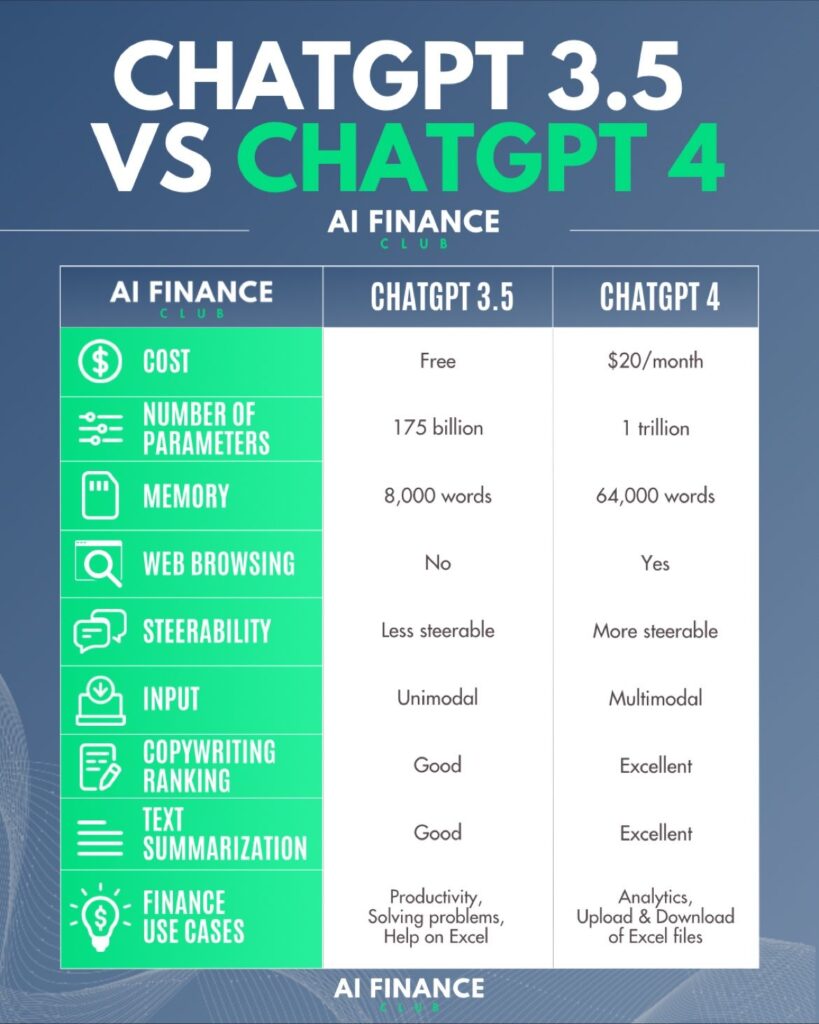ChatGPT 3.5 vs ChatGPT 4 – Which one should you use?
The evolution of AI in the finance sector has been greatly impacted by the advancements from ChatGPT 3.5 to ChatGPT 4.
Today, we are going to compare ChatGPT 3.5 vs ChatGPT 4, highlighting their features, capabilities, and specific applications in finance.
Table of Contents

ChatGPT 3.5: Features and Capabilities
ChatGPT 3.5, leveraging OpenAI’s GPT-3 architecture, introduced several impressive features:
- Cost: Free.
- Number of Parameters: 175 billion.
- Memory: Handles up to 8,000 words.
- Web Browsing: No capability for web browsing.
- Steerability: Less steerable compared to ChatGPT 4.
- Input: Unimodal, primarily text-based.
- Copywriting Ranking: Good.
- Text Summarization: Good.
- Finance Use Cases: Ideal for productivity enhancement, problem-solving, and Excel assistance.
Despite its strengths, ChatGPT 3.5 has limitations in handling complex, industry-specific tasks in finance due to its shorter memory and lack of web browsing.
Use Cases in Finance
ChatGPT 3.5 has been instrumental in the finance sector for:
- Automating routine financial tasks and increasing overall productivity.
- Solving basic financial problems and queries.
- Assisting with Excel for data management and analysis.
- Generating basic financial reports and content.
- Providing support in customer service for finance-related inquiries.
Its application is more aligned with general and foundational financial operations.
ChatGPT 4: A New Frontier
ChatGPT 4 builds on its predecessor’s capabilities and introduces advanced features:
- Cost: $20/month.
- Number of Parameters: 1 trillion.
- Memory: Significantly increased, with a 64,000-word context.
- Web Browsing: Enabled, allowing for more comprehensive information gathering.
- Steerability: More steerable, offering better control over responses.
- Input: Multimodal, including text, pictures, code, and sound.
- Copywriting Ranking: Excellent.
- Text Summarization: Excellent.
- Finance Use Cases: Well-suited for complex financial modeling, risk assessment, regulatory compliance, and detailed financial reporting.
Its expanded capabilities, including a larger memory, web browsing, and multimodal input, make it more adept at handling specialized and intricate tasks in finance.
Use Cases in Finance
ChatGPT 4, with its advanced features, is ideal for more sophisticated financial applications:
- Conducting in-depth financial modeling and complex scenario analyses.
- Performing comprehensive risk assessments and management.
- Offering detailed insights into financial regulations and compliance.
- Producing high-quality financial reports and market analyses.
- Crafting advanced investment strategies and financial advice.
Its enhanced capabilities make it a robust tool for specialized and high-level financial tasks.
The Bottom Line
The shift from ChatGPT 3.5 to ChatGPT 4 represents a significant development in AI technology. While both models offer valuable benefits, ChatGPT 4, with its advanced features, stands out as a more versatile and powerful tool in the finance sector.
Key Takeaways
- ChatGPT 3.5 is a cost-effective solution for basic finance tasks.
- ChatGPT 4 offers advanced finance capabilities for a subscription fee.
- The extended memory and web browsing in ChatGPT 4 enhance financial analysis.
- ChatGPT 4’s multimodal input is pivotal for complex finance operations.
- The progression from ChatGPT 3.5 to 4 signifies a major leap in AI for finance.
